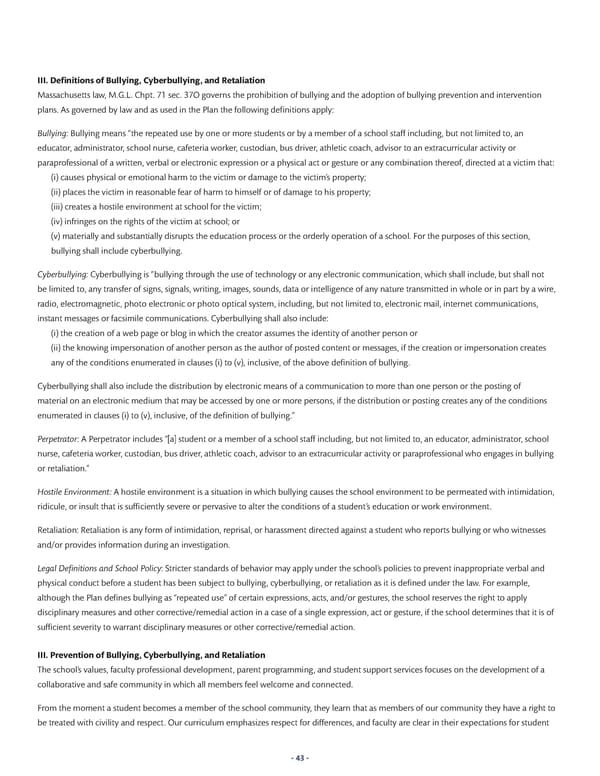III. De昀椀nitions of Bullying, Cyberbullying, and Retaliation Massachusetts law, M.G.L. Chpt. 71 sec. 37O governs the prohibition of bullying and the adoption of bullying prevention and intervention plans. As governed by law and as used in the Plan the following de昀椀nitions apply: Bullying: Bullying means “the repeated use by one or more students or by a member of a school sta昀昀 including, but not limited to, an educator, administrator, school nurse, cafeteria worker, custodian, bus driver, athletic coach, advisor to an extracurricular activity or paraprofessional of a written, verbal or electronic expression or a physical act or gesture or any combination thereof, directed at a victim that: (i) causes physical or emotional harm to the victim or damage to the victim’s property; (ii) places the victim in reasonable fear of harm to himself or of damage to his property; (iii) creates a hostile environment at school for the victim; (iv) infringes on the rights of the victim at school; or (v) materially and substantially disrupts the education process or the orderly operation of a school. For the purposes of this section, bullying shall include cyberbullying. Cyberbullying: Cyberbullying is “bullying through the use of technology or any electronic communication, which shall include, but shall not be limited to, any transfer of signs, signals, writing, images, sounds, data or intelligence of any nature transmitted in whole or in part by a wire, radio, electromagnetic, photo electronic or photo optical system, including, but not limited to, electronic mail, internet communications, instant messages or facsimile communications. Cyberbullying shall also include: (i) the creation of a web page or blog in which the creator assumes the identity of another person or (ii) the knowing impersonation of another person as the author of posted content or messages, if the creation or impersonation creates any of the conditions enumerated in clauses (i) to (v), inclusive, of the above de昀椀nition of bullying. Cyberbullying shall also include the distribution by electronic means of a communication to more than one person or the posting of material on an electronic medium that may be accessed by one or more persons, if the distribution or posting creates any of the conditions enumerated in clauses (i) to (v), inclusive, of the de昀椀nition of bullying.” Perpetrator: A Perpetrator includes “[a] student or a member of a school sta昀昀 including, but not limited to, an educator, administrator, school nurse, cafeteria worker, custodian, bus driver, athletic coach, advisor to an extracurricular activity or paraprofessional who engages in bullying or retaliation.” Hostile Environment: A hostile environment is a situation in which bullying causes the school environment to be permeated with intimidation, ridicule, or insult that is su昀케ciently severe or pervasive to alter the conditions of a student’s education or work environment. Retaliation: Retaliation is any form of intimidation, reprisal, or harassment directed against a student who reports bullying or who witnesses and/or provides information during an investigation. Legal De昀椀nitions and School Policy: Stricter standards of behavior may apply under the school’s policies to prevent inappropriate verbal and physical conduct before a student has been subject to bullying, cyberbullying, or retaliation as it is de昀椀ned under the law. For example, although the Plan de昀椀nes bullying as “repeated use” of certain expressions, acts, and/or gestures, the school reserves the right to apply disciplinary measures and other corrective/remedial action in a case of a single expression, act or gesture, if the school determines that it is of su昀케cient severity to warrant disciplinary measures or other corrective/remedial action. III. Prevention of Bullying, Cyberbullying, and Retaliation The school’s values, faculty professional development, parent programming, and student support services focuses on the development of a collaborative and safe community in which all members feel welcome and connected. From the moment a student becomes a member of the school community, they learn that as members of our community they have a right to be treated with civility and respect. Our curriculum emphasizes respect for di昀昀erences, and faculty are clear in their expectations for student - 43 -
 All-School Employee Handbook AY 24-25 Page 42 Page 44
All-School Employee Handbook AY 24-25 Page 42 Page 44